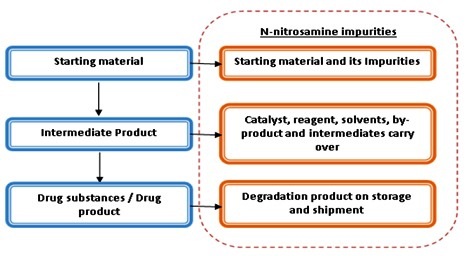As the pharmaceutical industry con What are the key updates in current version of Questions and answers for marketing authorization holders/applicants on the CHMP Opinion for the Article 5(3) of Regulation (EC) No 726/2004 referral on nitrosamine impurities in human medicinal products?
EMA Published Rev: 14 of EMA/409815/2020 on 21st December 2022. Following are the summary of changes and details of newly introduced Q&A.
• Introduction of Q&A 22, that defines approach to control presence of Nitrosamine exceeding the AI while CAPAs are being implemented.
• Updation of Q&A 20 to consider the possibility of an interim limit based on the LTL approach during CAPA implementation.
• Updation of Q&A 21 for increased clarity on the application of the temporary universal limit.
New Q&A 22:
As per newly introduced Q&A 22, In accordance with the regulatory steps taken by authorities following the identification of an Nitrosamine exceeding the AI and outlined in Q&A20, the less-than lifetime (LTL) concept or the use of interim limits may be considered by the lead authority and NCAs on a temporary basis in order to inform market actions and at the same time ensure availability of medicines. MAHs are expected to establish and implement corrective and preventive actions (CAPAs) in authorized medicines without any delays in order to ensure patients safety and product quality.
Nevertheless, it is recognized that implementation of CAPAs may require some time before the MAH is able to mitigate the presence of the identified N-nitrosamine below the established AI. Therefore, in order to avoid unnecessary risk of supply disruptions, a harmonized approach promoting the establishment of interim limits in a streamlined way is agreed. The approach is applicable to all authorized products that have:
• A duration of treatment not exceeding 10 years and
• CAPA implementation timeline of up to 3 years from the establishment and publication of the AI (nevertheless MAHs are expected to expedite CAPAs implementation).
| Treatment duration | Up to 12 months | >12 months up to 10years |
| Interim limit | 13.3 x AI* | 6.7xAI* |
In any case, the limit should not exceed 1.5 µg/day unless the established AI (Table 1, Q10) is > 1.5 µg/day.
The approach is not applicable to the below instances where other approaches may be considered on a case-by-case basis in consultation with the appropriate regulatory authority:
• Authorized medicines taken for a lifetime (>10 years);
• CAPA implementation exceeding 3 years from the establishment and publication of the AI;
• New/ongoing regulatory applications.
The above interim limits are based on the LTL approach outlined in the ICH M7 guideline, using the two most conservative adjustment factors (6.7 and 13.3 x AI). The application of these adjustment factors would not be expected to exceed a theoretical excess cancer risk of 1 in 100,000 during the period of CAPA implementation.
The approach is intended to be evaluated by the lead authority during the assessment of the case and is expected to be communicated by the lead authority to the concerned MAH as part of assessment conclusions. In terms of retrospective application, where more restrictive interim limits were previously agreed for some products as part of case assessment, upon request from the MAH, the lead authority can re-assess interim limits taking into consideration this approach to control presence of Nitrosamine exceeding the AI during CAPA implementation.
MAHs are expected to ensure that the implementation of adequate controls for the detected nitrosamines is done as a matter of priority. During the use of the interim limit, monitoring measures may be evaluated by the lead authority as required.
Source: EMA

Office Address
No 182, Zhaohui Road, Hangzhou 310014, China
No 139, Mayuri Nagar, Hyderabad 500049, India
Quick Services

